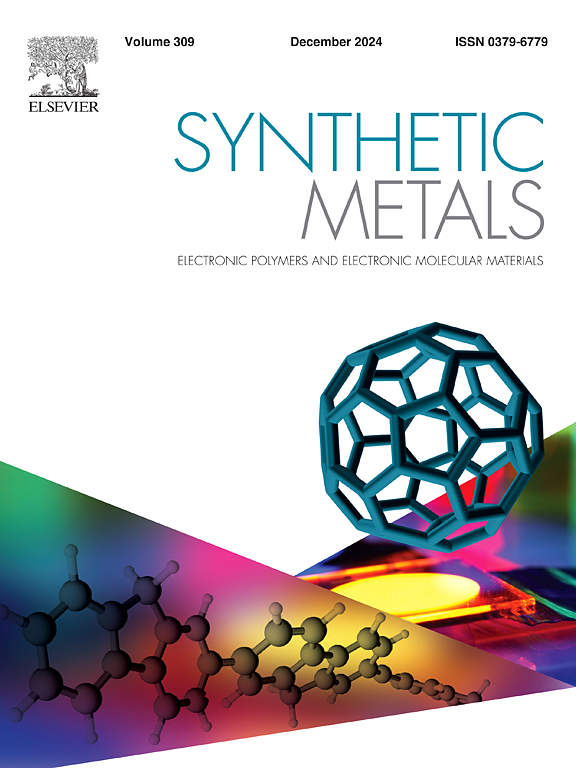不同噻吩π桥单元对二硝化D-π-A-π-D聚合物电化学和电致变色性能的影响
IF 4.6
3区 材料科学
Q2 MATERIALS SCIENCE, MULTIDISCIPLINARY
引用次数: 0
摘要
本文通过Stille偶联反应成功合成了以二硝化苯并噻唑为受体单元、EDOT为供体单元、EDOT和3-十二烷基噻吩分别为π桥单元的两个二硝化D-π-A-π-D型单体,并通过电化学聚合法制备了相应的二硝化聚合物P(2EDOT-2NO2-BT)和P(EDOT- c12th - 2no2 - bt)。通过光学、循环伏安法、光谱电化学和动力学研究,系统地讨论了π桥单元对二硝化单体及其相应的D-A聚合物的光电性能、电化学性能和电致变色性能的影响,并进一步揭示了结构-性能关系。与以EDOT为π桥单元的单体2EDOT-2NO2-BT相比,以3-十二烷基噻吩为π桥单元的EDOT- c12th - 2no2 - bt的吸收光谱和荧光光谱发生蓝移,Stokes位移(196 nm)更大,光学带隙(1.76 eV)更大。这两种双硝化单体具有非常低的荧光量子产率和起始氧化电位(0.74-0.77 V),这使它们成为电沉积高质量电致变色聚合物薄膜的理想选择。由于表面形貌疏松多孔,这两种二硝化聚合物均表现出良好的氧化还原活性和氧化还原稳定性(经过1000次循环后,其保留电活性均在80 %以上),以及良好的电致变色性能,具有明显且可逆的多色变化、良好的光学稳定性、良好的光学对比度(33.24 %)、较短的响应时间(低至1.5 s)、良好的显色效率(152.47 C−1 cm2)和记忆效应。总之,这两种二硝化聚合物都具有良好的氧化还原稳定性和电致变色性能,为基于二硝化聚合物的电致变色器件开辟了新的可能性。本文章由计算机程序翻译,如有差异,请以英文原文为准。
Effects of different thiophene π-bridge units on electrochemical and electrochromic properties of di-nitrated D-π-A-π-D polymers
In this paper, two di-nitrated D-π-A-π-D type monomers with di-nitrated benzothiadiazole as the acceptor unit, EDOT as the donor unit, and EDOT and 3-dodecylthiophene as the π-bridge units, respectively, were successfully synthesized by Stille coupling reactions, and their corresponding di-nitrated polymers (P(2EDOT-2NO2-BT) and P(EDOT-C12Th-2NO2-BT)) were obtained by electrochemical polymerization method. Through optical, cyclic voltammetry, spectroelectrochemistry and kinetic studies, the effects of π-bridge units on the optoelectronic properties, electrochemical and electrochromic properties of di-nitrated monomers and their corresponding D-A polymers were systematically discussed, and the structure-property relationship was further revealed. Compared to the monomer 2EDOT-2NO2-BT that using EDOT as the π-bridge unit, the absorption and fluorescence spectra of EDOT-C12Th-2NO2-BT that using 3-dodecylthiophene as the π-bridge unit are blue-shifted, with a larger Stokes shift (196 nm) and optical band gap (1.76 eV). Both of these di-nitrated monomers have very low fluorescence quantum yields and onset oxidation potentials (0.74–0.77 V), which make them ideal for electrodepositing high-quality electrochromic polymer films. Due to the loose and porous surface morphology, both these two di-nitrated polymers exhibit favorable redox activity and redox stability (the retained electroactivity of them were both over 80 % after 1000 cycle), as well as favorable electrochromic performance with obvious and reversible multicolor color change, good optical stability, decent optical contrast (33.24 %), short response time (as low as 1.5 s), good coloration efficiency (152.47 C−1 cm2) and memory effect. Overall, both these two di-nitrated polymers have good redox stability and electrochromic properties, opens new possibilities for electrochromic devices based on the di-nitrated polymers.
求助全文
通过发布文献求助,成功后即可免费获取论文全文。
去求助
来源期刊

Synthetic Metals
工程技术-材料科学:综合
CiteScore
8.30
自引率
4.50%
发文量
189
审稿时长
33 days
期刊介绍:
This journal is an international medium for the rapid publication of original research papers, short communications and subject reviews dealing with research on and applications of electronic polymers and electronic molecular materials including novel carbon architectures. These functional materials have the properties of metals, semiconductors or magnets and are distinguishable from elemental and alloy/binary metals, semiconductors and magnets.
 求助内容:
求助内容: 应助结果提醒方式:
应助结果提醒方式:


